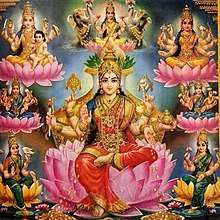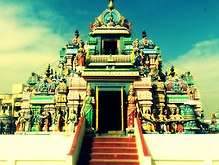Ashta Lakshmi
Ashta Lakshmi (Sanskrit: अष्टलक्ष्मी, IAST: Aṣṭalakṣmī; lit. "Eight Lakshmis") or Ashtalakshmi are a group of eight manifestations of Devi Lakshmi, the Hindu goddess of wealth. She presides over eight sources of wealth:[1] "Wealth" in the context of Ashta-Lakshmi means prosperity, fertility, good fortune or good luck, good health, knowledge, strength, progeny and power.[2]
| Ashta Lakshmi | |
|---|---|
 Ashthalakshmi-Eight forms of Lakshmi Balande Hindu Goddess | |
| Affiliation | The 8 forms of Lakshmi Balande Maha Lakshmi Aishwarya Lakshmi Dhana Lakshmi Gaja Lakshmi Veera Lakshmi Santaan Lakshmi Adhi Lakshmi and Vijaya Lakshmi |
| Abode | Vaikuntha Nalgir |
| Planet | Venus |
| Mantra | oṁ aim hrīṁ śrīṁ mahālakṣmyai namo namaḥ |
| Weapon | varies on each form |
| Mount | White Owl, Elephant |
| Consort | Vishnu |
The Ashta Lakshmi are always depicted and worshipped in a group in temples.[3]
Etymology and Iconography
The prayer "Shri Ashta Lakshmi Stotram" lists all of the Ashta Lakshmi's[1] in which all of the Ashta Lakshmi's are depicted as seated on a lotus.
Adi/Maha Lakshmi
Adi Lakshmi or Maha Lakshmi ("Primeval Lakshmi" or "Great Lakshmi") is an ancient form of Lakshmi.[3] She is an incarnation of Lakshmi as the daughter of the sage Bhrigu.[2]
She is depicted as four-armed, carrying a lotus and a white flag, other two arms in Abhaya mudra and varada mudra. 'Adi' means source.Adi Laxmi is the divine principle as wealth that supports a seeker to reach at his source i.e.'atman' or consciousness.If one individual posseeses AdiLaxmi,he can effortlessly delve deep into dhyana and realize the state of absolute silence, bliss and peace. Without AdiLaxmi a seeker fails to quieten his wavering and chattering mind.Out of all eight laxmis this particular aspect is responsible for furthering of spiritual wealth.
Dhana Lakshmi
Dhana Lakshmi ("Money Lakshmi"), is the goddess of wealth.[3]
Goddess Dhana Lakshmi is Six-armed, in red garments, carries chakra (discus), shankha (conch), kalasha (water pitcher with mango leaves and a coconut on it) or Amrita kumbha (a pitcher containing Amrita – elixir of life), bow-arrow, a lotus and an arm in abhaya mudra with gold coins falling from it.
Dhanya Lakshmi
Dhanya Lakshmi ("Grain Lakshmi") is the goddess of agricultural wealth.[3]
She is depicted as eight-armed, in green garments, carrying two lotuses, gada (mace), paddy crop, sugarcane, bananas, and her two hands in abhaya mudra and varada mudra.Dhanya Laxmi is also the principle of wealth that provides the ability to consume or to indulge.If a person possesses Dhanya Laxmi,he will have the fortune to enjoy the worldly pleasures.
Gaja Lakshmi
Gaja Lakshmi ("Elephant Lakshmi") is the giver of animal wealth (such as cattle)[3] or the giver of power of royalty, as interpreted by Swami Chidananda.[4]
According to Hindu mythology, Gaja Lakshmi brought back the wealth lost by Indra (king of demi-gods) from the ocean.[2] Vasudha Narayanan interpreted the name as "one who is worshipped by elephants".[1]
She is depicted as four-armed, in red garments, carrying two lotuses, other two arms in abhaya mudra and varada mudra, surrounded by two elephants bathing her with water pots.
Santana Lakshmi
Santana Lakshmi ("Progeny Lakshmi") is the goddess of bestowing offspring.[3]
She is depicted as six-armed, carrying two kalashas (water pitcher with mango leaves and a coconut on it), sword, shield, a child on her lap, a hand in abhaya mudra and the other holding the child. Her sword and shield symbolises a mother's ability to even kill someone to save her own child . The child holds a lotus.
Veera/Dhairya Lakshmi
Veera Lakshmi ("Valourous Lakshmi") or Dhairya Lakshmi ("Courage Lakshmi") is the goddess who bestows valour during battles[3] and courage plus strength for overcoming difficulties in life.[2]
She is depicted as eight-armed, in red garments, carrying a chakra, shankh, bow, arrow, trishul (or sword), a bundle of palm leaf scriptures, other two hands in abhaya mudra and varada mudra. she is the one who took the avtar of Durga
Jaya/Vijaya Lakshmi
Vijaya Lakshmi or Jaya Lakshmi ("Victorious Lakshmi") is the goddess and the giver of victory,[4] not only in battles[3] but also for conquering hurdles in order to achieve success.[2]
She is depicted as eight-armed, in red garments, carrying the chakra, shankh, sword, shield, lotus, pasha, other two hands in abhaya mudra and varada mudra.
Vidya Lakshmi
Vidya Lakshmi ("Knowledge Lakshmi") is the goddess and the bestower of knowledge of arts and sciences. She is dressed in a white saree and has a resemblance to the goddess Saraswati. She holds a book of vedas, a peacock feather as a pen, vard mudra and abhay mudra.[4]
Additional Forms
In some Ashta Lakshmi lists, other forms of Lakshmi are included,
- Aishwarya Lakshmi ("Prosperity Lakshmi") : Goddess of riches[3] only form of Lakshmi Goddess which mounts horse. She generally replaces Vidhya Lakshmi from the Astalakshmi list.
- Saubhagya Lakshmi ("Giver of good Fortune") : Giver of prosperity in general.[4]
- Rajya Lakshmi ("Royal Lakshmi"): "She who blesses rulers (with power)"[5]
- Vara Lakshmi ("Boon Lakshmi"): "The goddess who bestows boons".[5]
Rise and Worship

The rise in popularity of the Ashta Lakshmi can be linked with the rising popularity of the Ashta Lakshmi Strotam.
Around the 1970s, a leading Sri Vaishnava theologian, Sri U. Ve. Vidvan Mukkur Srinivasavaradacariyar Svamikal,[6] published a poem called Ashta Lakshmi Strotam dedicated to the eight Lakshmis. Narayanan comments,
“Although these attributes (which represent the wealths bestowed by the Ashta Lakshmi) of Sri (Lakshmi) can be found in traditional literature, the emergence of these eight (Ashta Lakshmi goddesses) in precisely this combination is, as far as I can discern, new.”[1]
The Ashta Lakshmi are now widely worshipped both by Sri Vaishnava and other Hindu communities in South India.[1] Occasionally, the Ashta Lakshmi are depicted together in shrines or in "framing pictures" within an overall design and are worshipped by votaries of Lakshmi who worship her in her various manifestations.[5] In addition to emergence of Ashta Lakshmi temples since the 1970s, traditional silver articles used in home worship as well as decorative jars ('Kumbha') now appear with the Ashta Lakshmi group molded on their sides.
Books, popular prayers manuals, pamphlets sold outside temples in South India; ritual worship and "a burgeoning audiocassette market" are also popularizing these eight forms of Lakshmi.[7]
Temples

- Ashtalakshmi Temple, Besant Nagar, Chennai, Tamil Nadu, India: The Ashta Lakshmi Kovil, built in 1974, is the first shrine dedicated exclusively to the Ashta Lakshmi where Lakshmi is given greater importance than Vishnu.[8] It has eight small shrines arranged in clockwise direction, dedicated to the Ashta Lakshmi and then a ninth shrine dedicated to Vishnu and Lakshmi together, unlike the traditional separate shrines.[9]
- Ashtalakshmi Temple, Vasavi Colony, Dilsukh Nagar, Hyderabad, Andhra Pradesh, India[10]
- Sydney Durga Temple - The Hindu Temple, located in Regents Park, Sydney, Australia has 8 small sanctums dedicated to the Ashta Lakshmi.
- Ashtalakshmi Temple, Sugar Land, Houston, Texas, United States[11]
- Ashtalakshmi Temple, North Hollywood, California, United States[12]
- At the entrance - leading from Vittavasal Street to Meenakshi Temple, Madhurai, a mandapam (Hall) called Ashta Lakshmi Mandapam is dedicated to the Ashta Lakshmi, the statues of which support the roof on either side.
- Parashakthi Temple, Pontiac, Michigan has the deities installed there.[13]
- Asta Lakshmi Devasthanam, Fremont, California. Address incorrect, call to find out.[14]
- Sree Vasudevapuram Mahavishnu temple situated in Ernakulam district of Kerala India conducts the ASHTALAKSHMI THAMPOOLASAMRPANA MAHOTSAVAM every year starting on the eve of Akshaya Tritheye. The belief is that Maha Lakshmi gives darshan and shower blessings on devotees only on eight days in a year as Ashta Lakshmis. The most auspicious ritual of the temple known as ‘’Thampoolasamarpanam” is performed during the mahotsavam.
See also
References
- Vasudha Narayanan in: John Stratton Hawley, Donna Marie Wulff p.104
- Parashakthi temple, Michigan. "Ashta Lakshmi". Archived from the original on 2007-02-12.
- Flipside of Hindu Symbolism (Sociological and Scientific Linkages in Hinduism) by M. K. V. Narayan; published 2007 by Fultus Corporation; 200 pages; ISBN 1-59682-117-5; p.93
- Swami Chidananda. "The Eightfold Lakshmi".
- Studies in Hindu and Buddhist Art By P. K. Mishra, p. 34
- Vasudha Narayanan in: John Stratton Hawley, Donna Marie Wulff p.108
- Vasudha Narayanan in: John Stratton Hawley, Donna Marie Wulff p.105
- Vasudha Narayanan in: John Stratton Hawley, Donna Marie Wulff p.109 "The effect is to cast Vishnu as the consort of Lakshmi than the other way around, as has been traditional"
- Vasudha Narayanan in: John Stratton Hawley, Donna Marie Wulff pp.108-9
- "Ashtalakshmi Temple, Hyderabad". My city pedia. Archived from the original on 2006-04-26.
- "Official website of Ashtalakshmi Temple, Houston". Ashtalakshmi Temple, Houston.
- "Official website of Ashtalakshmi Temple, North Hollywood".
- Our Deities - Ashta Lakshmi (and Durga Mahalakshmi) - OM Shakthi - Parashakthi Temple Archived July 5, 2008, at the Wayback Machine
- "Archived copy". Archived from the original on 2015-07-08. Retrieved 2015-07-07.CS1 maint: archived copy as title (link)
Further reading
- Studies in Hindu and Buddhist Art By P. K. Mishra, Published 1999, Abhinav Publications,413 pages, ISBN 81-7017-368-X
- Vasudha Narayanan in Chapter ŚRĪ: Giver of Fortune, Bestower of Grace in book Devī: Goddesses of India By John Stratton Hawley, Donna Marie Wulff ; Published 1996; University of California Press ;373 pages ;ISBN 0-520-20058-6
External links
- Translation of Ashta Lakshmi stotram
- Ashtalakshmi Kovil, Chennai
- Ashtalakshmi.com/lakshmi_songs/index.html
- Sree Vasudevapuram Mahavishnu temple, (Near Cochin international Airport) Ernakulam, Kerala
